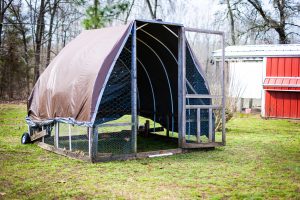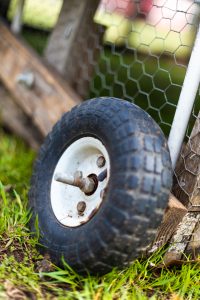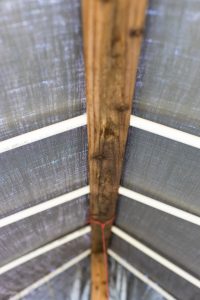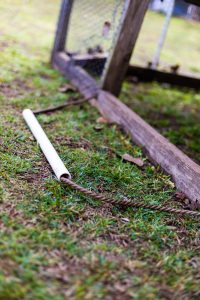The term “chicken tractor” is commonly used in today’s circle of chicken collectors. No, we are not referring to the big green thing with a deer on it. We are referring to simply a movable chicken shelter without a bottom.

Uses and Benefits
A chicken tractor is most commonly used for those wanting to raise their own meat birds. However, I have also found they come in handy if you ever plan on adding baby chicks to your existing flock. I have used our chicken tractor over 6 times as a “grow-out pen,” for teenage chickens. You can also use it for young ducks, geese, or turkey poults!
The chicken tractor acts as a mobile home. It allows you to simply lift and pull it onto fresh grass daily. That way, your birds get fresh ground, while also leaving some fertilizer behind from the day before. If you move it as needed, the chickens have a more hygienic place to live, and you do not have to worry about the build-up of feces.
(Laying hens need a more permanent home, like a coop and run)
Requirements
Chicken tractors can come in any shape or form, with the design totally up to its builder. After trying several different types, we settled on the taller, walk-in version. We found it is easier to clean and tend to the chickens when you have enough head room to walk in with them. There are a huge array of examples online, or maybe you can design a new model for yourself!
Regardless of looks, all chicken tractors need these to be functional:
1. Offer some shade, some sun.
It may not look classy, but a good quality tarp over the top of the tractor offers shade, while still being lightweight. We have had our same brown tarp over our tractor for over 4 years and it is still holding up nicely!
2. Ventilation
You don’t want the tractor to be stuffy. There needs to be at least 2 wire openings for a flow of air.
3. Door.
Whether to clean, fill water/feed, and catch chickens, you need a way in and out.
4. Small wheels on the back.
The wheels on the back allow a smoother ride when lifting and pulling. The chickens will also learn to get up and stay away from the back of the pen when it’s moving time!

5. Lightweight
This is a major requirement. You need to think less heavy, and more light. You will be pulling this tractor about 5 feet everyday onto new grass. Use PVC pipes for the hoop roof, and a tarp instead of metal for the top.

6. Way to pull it
A simple rope under the door is needed to pull it. Add a piece of PVC pipe over the rope makes it easier on the hands.

7. One corner totally enclosed
Although you need the bottom half to be mostly open for ventilation, be sure to have one corner totally enclosed to the ground. I have done this by keeping one corner flap of tarp unstapled. If a big storm is coming, I’ll just drape it down and put a heavy bucket on it to keep from blowing around.
8. SMALL wire on the bottom half
Since you’ll most likely be housing teenage birds first, the wire on the bottom needs to be small. The smaller the wire, the better protection from predators. Two layers of chicken wire, or even better, a single layer of rabbit wire, are best. Also make sure your tractor is as flush with the ground as possible. With your birds being on the ground and visible, all manner of raccoons, opossums, and foxes will try their best to get through the wire!
A chicken tractor is a great tool for the intermediate chicken owner. They offer a space for growing out youngsters, raising meat birds, and a good way to keep the grass mowed down! Give one a try and you’ll soon be building the poultry empire of your dreams!